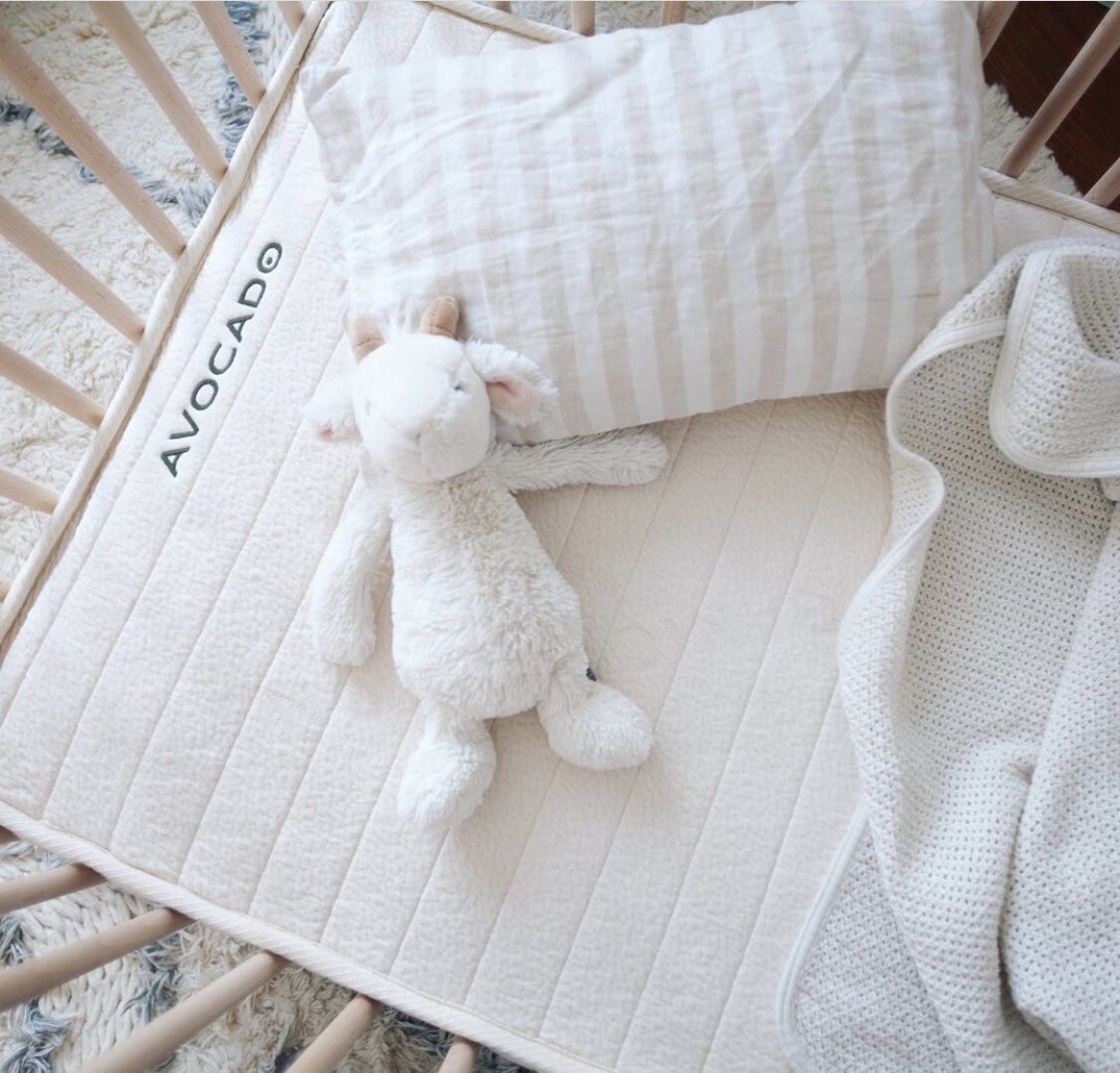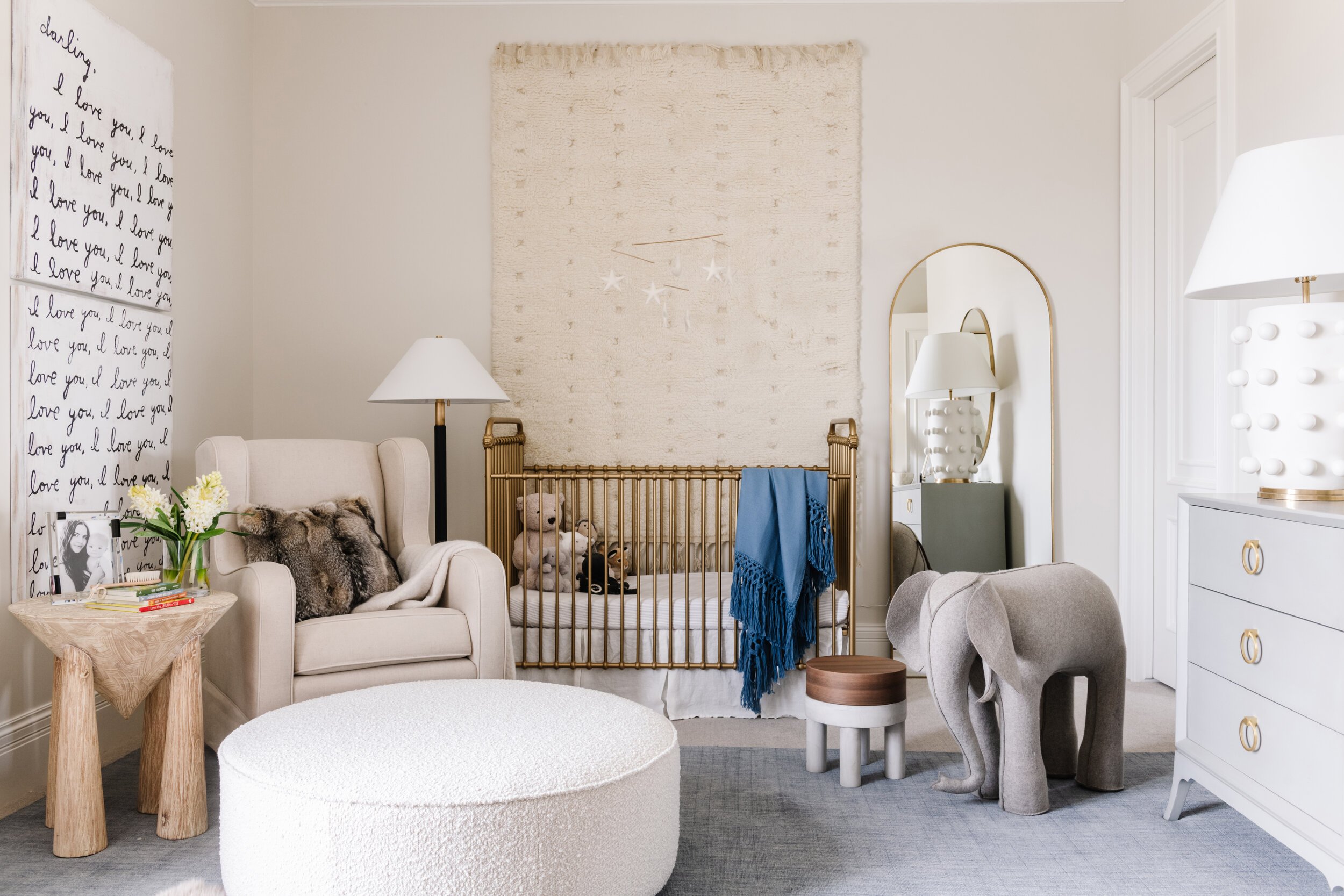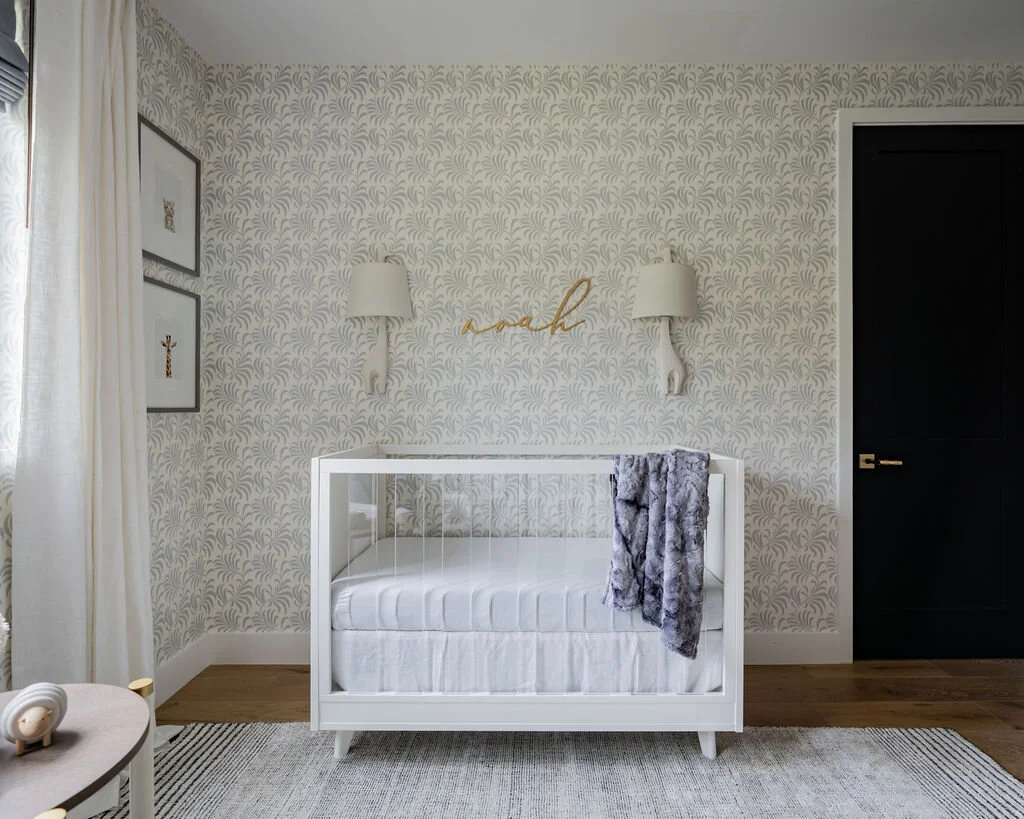7 TIPS TO HELP YOU CREATE A HEALTHY & TOXIN-FREE NURSERY
Expecting a baby, especially if it’s your first, is one of the most exciting times of your life. You’re thrilled, nervous, feeling allll the emotions and just soaking in everything that this journey is about. When you start to dive into baby products, gear, clothing, feeding - there are so many choices! Then as you start building your inspiration boards for your dream nursery, you realize there is so much research to do to get you prepared. What is the best? What is the safest? What do I really need? Yet, your main focus is to do everything you can to keep your babies safe and healthy. But still, you don’t know where to begin. With so many labels like “organic”, “Greenguard Certified”, “Low or No VOC”, “Phthalate free”, it’s important to know what to look for. Feeling overwhelmed is exactly what most new mama’s experience. And when it comes to planning your nursery, I’ve got you covered.
Babies and children are the most sensitive to environmental toxins and harmful chemicals as they breathe in more air per pound of body weight than adults, getting a bigger dose of whatever is out there. They have more susceptible immune systems and underdeveloped organs. The sad news is that your nursery room selections may be off gassing into the air they breathe, which is why it’s important to eliminate as many potentially harmful sources as possible to improve your Indoor Air Quality (IAQ).
I’ve linked the brands and products below that I’ve found to be the best in their categories. Use this as a guide so you can read further into what makes some products safer than others from conventional brands. You’ll be on your way to making informed decisions when it comes to what you put in your nursery in no time. Because what you choose does matter.
Here are a few quick tips to start your baby’s room off right - as safe and toxin-free as possible.
1) CHOOSE A NON-TOXIC OR NATURAL PAINT: Wall paint is one of the quickest ways to make a space feel brand new and help pull your design together. Yet it is one of the biggest offenders of toxin exposure and poor indoor air quality. Why? Because paint can contain harmful chemicals known as Volatile Organic Compounds (VOC’s). These VOC’s will off-gas (release harmful chemical emissions) into the air you and your family breathe. And when inhaled, can contribute to several health problems. Many conventional brands now offer “low VOC” or “no VOC” options, but keep in mind, this doesn’t make them non-toxic. They may still contain low levels of VOC’s, and sometimes contain other solvents or additives, biocides or fungicides. When you’re at a paint store, don’t be afraid to ask questions! Make sure your paint base and color pigments don’t contain any extra additives or chemical solvents. Ask for the MSDS sheets. Check the VOC content. By law, paint can contain VOC levels up to 150 grams per liter. The lower the number, the better. The number generally accepted for a low-VOC paint is less than 50 grams per liter; a paint labeled “zero-VOC” has fewer than 5 grams per liter according to the EPA Reference Test Method 24.
Your safest choice would be to select your paint color from brands whose values and mission place your health and indoor air quality as a priority. These brands have taken the steps to drastically reduce or eliminate all the nasties. That being said, non-toxic or natural paints are as safe as paint gets. Their natural, raw ingredients include things like:
Water, vegetable oils, essential oils, plant dyes, natural minerals, milk protein, linseed oil, natural latex, beeswax.
And a friendly reminder - stay away from the fumes as best as possible, never paint the room yourself if you are pregnant. Choose your brand, choose your special color, sit back, relax and let the professionals take care of that for you. Have the room painted several months in advance of your due date if possible and open the windows throughout the day to air out for several days after application.
My three favorite brands are below; and ones I use for my own home as well as client’s rooms. These are all safer than conventional paint.
Image from Kalon Studios
2) SHOP FOR A NATURAL BASSINET & CRIB: Many parents choose to start their baby off in a bassinet next to their bed (to keep a close eye and more convenient for those early weeks when baby is eating and waking every couple hours) and then transition to the crib in baby’s nursery at three or four months or so. While others opt to let baby sleep in the crib their first night at home. Whichever option you choose is your preference, your baby will spend most of his/her hours sleeping in this space so making sure that your bassinet and/or crib is made of natural materials is a step in the right direction. A few things to look for when choosing your furnishings:
Avoid: Engineered wood, medium density fiberboard (MDF), plywood or veneers which all use glues that may contain formaldehyde.
Look for: Solid wood construction (eliminates the use of toxic glues/adhesives). Look for Low or No VOC finishes (stain or paint). Unfinished wood would be a great choice if you love a natural look or you can find a natural paint color and have it painted, knowing your finish is toxin-free. An easier way to locate healthier products is to find those that have been labeled with the Greenguard Gold certified seal. This is a third party certification that manufacturers can receive on tested products to verify that they meet the strictest standards for chemical emissions and VOC’s, such as formaldehyde or phthalates. Greenguard Gold products have been independently tested and scientifically screened for over 10,000 chemicals and more than 360 VOC’s that pollute your indoor air. Greenguard certified products help reduce indoor air pollution and chemical exposure. This to me, takes some of the research stress off of your shoulders and would give me peace of mind. A few of my favorite brands below that use natural materials with no additives or toxins, or have a line of Greenguard Gold certified options.
Restoration Hardware now has a large selection of Greenguard certified options.
Image from Carly Cardellino via @Avocadomattress
3) CHOOSE A NON-TOXIC MATTRESS & PAD FOR HEALTHIER SLEEP: Your baby will sleep ALOT. For the first three months, they sleep more than they are awake. Between 14-17 hours in a 24 hour day! Making the mattress that they will be spending countless hours sleeping on very important. Most conventional mattresses are made with flame retardants to meet flammability regulations. They may also contain VOC’s, chemical adhesives, polyurethane foam or vinyl waterproofing - exposing your baby to unhealthy levels of chemical emissions while they sleep, all while their body heat intensifies these emissions. But flame retardants seem to make sense right? If we can reduce the risk of potential fires, why wouldn’t we? The problem is that the chemicals in flame retardants have been known to cause health problems - like endocrine and immune system disruption. A truly non-toxic brand makes it their mission to meet those flammability standards without the use of harmful chemicals. For example, organic wool is an all-natural fire barrier and an alternative that I, and I know you, will prefer over chemical flame retardants any day! Purchasing a non-toxic mattress is something I’d make a priority. Be aware of brands claiming that their products are organic but don’t have the right certifications. Make sure you are aware of all of the materials used. One organic component doesn’t make the entire mattress toxin-free. A healthy mattress needs to use organic materials from beginning to end. Mattresses using materials certified by GOTS (Global Organic Textile Standard) or GOLS (Global Organic Latex Standard) in its entirety are the best of the best. There are other certifications out there such as Oeko-Tex and Certi-Pur, however their certification standards are not high enough. Stick with GOTS or GOLS certifications to ensure a safer sleep environment for your baby. By the way, your health is important too - consider investing in a healthier mattresses for yourself as well if you haven’t already! Both brands below offer crib to California King options.
4) VENTILATION AND CLEAN AIR IS KEY: As we know from the above three points, the items that we put in the room, if not certified non-toxic, can be increasing your baby’s exposure to air pollutants. Studies from the Environmental Protection Agency (EPA) on human exposure to air pollutants show that the indoor levels can be up to five times higher than outdoors due to those chemical-laden products and lack of ventilation. Sources that may be reducing the quality of your indoor air range from dust, mold spores, pet dander, smoke, fuel burning appliances, household cleaners, building products and as we’ve discussed above, this includes furnishings and decor. Depending on the source, the emissions can release intermittently or continuously. Some symptoms of exposure can be sneezing, coughing, wheezing, allergies, runny nose, asthma attacks. The purpose of an air purifier is to effectively trap these allergens and VOC’s so your baby won’t be affected. Monitoring the IAQ level in your home will give you a better idea on what steps to take to keep your air clean and pure. I highly recommend investing in a good air purifier that removes any lingering gases, chemicals, VOC’s and formaldehyde.
The most effective and safest units will be certified by the California Air Resources Board (CARB), to meet an ozone emission concentration limit of 0.050 parts per million. And will also include these features: True HEPA (high-efficiency particulate air) filter, a UV light to kill germs from the air, an activated carbon filter to trap chemical vapors and odors - keeping the room smelling fresh. This will give you peace of mind in knowing that the air your baby is breathing is as safe as can be.
Replacement filters can be costly depending on the unit, so depending on what you are comfortable spending up front and then on replacements filters, I would keep this in mind. Every unit is designed to work in rooms of a certain size, so make sure you are selecting the appropriate purifier for the size of your room to maintain the highest efficiency.
A note on ionic purifiers and ozone generators - Some units offer an ionizing function, which may be ok if you are able to turn this function off. However, this ionizing process emits a small amount of ozone which is actually a throat and lung irritant, triggering asthma. If you can’t turn this function off, then move on to a safer product.
Last - remember that fresh air exchange is key so if you aren’t able to purchase an air purifier at this time (hey! put it on your baby shower registry) then open some windows, and get some good air circulation going on in the space.
5) KEEP EMF’S AS LOW AS POSSIBLE: No matter how hard we try, it seems that we can’t stay away from our electronic devices. Over the last several years we have been bombarded with modern technologies, smart function devices, wifi - all things we feel make our lives easier. However, these devices are emitting varying low frequencies of Electromagnetic Field (EMF) radiation which can have negative impacts on a developing baby. I understand this can be a controversial topic because there isn’t enough significant data and the effects on health are not yet fully known. However, risks of exposure can be oxidative stress, decrease in immune response, decline in sleep quality. So, how can you be precautionary to reduce your baby’s exposure in the nursery?
-First, try to keep all mobile devices out of the room. The closer you are to the polluting device, the greater the impact. Time with your baby is more important and our cell phones can be a distraction anyway, so minimizing use is a good thing!
-Turn all devices off or on airplane mode at night while you sleep. Same goes for the WiFi router.
-If your internet router is in or near the nursery, I would definitely consider moving it and keeping it off any shared bedroom walls. Set your nursery up in a room furthest away from the wifi router and breaker boxes. Being mindful goes a long way. You’ve got this!
-Purchase a hard wired baby monitor instead of a wireless model.
Image from Odin Parker
6) SHOP FOR NATURAL WOOD & PLASTIC-FREE TOYS: Plastic can have bisphenol A (BPA) which has proven to be a hormone disruptor, and polyvinyl chloride (PVC) which can contain phthalates, a known carcinogen. This is why there is a strong push to reduce the use of single-use plastics in your home. The same goes for plastic in toys - which still boggles my mind how in the world this is allowed at all, especially in children’s toys.
Babies will put anything in their mouths, so being aware and understanding what materials are used in the making of their teething rings and toys is very important. You would never knowingly allow your child to suck on a toy that was made with toxic glues containing formaldehyde, lead paints or stains. So let’s assume you already knew all this and just need some pointers on where to find the cutest natural wood toys! I love natural toys in nurseries and kids rooms anyways because of their neutral colors. They don’t stand out like the primary colored plastic toys which are not only harmful to your health, they aren’t the prettiest if I’m being honest. Natural wood toys will also last for years to come, can be made of sustainable materials and are biodegradable. They are well made and will stand the test of time.
Another thing to keep in mind when it comes to play items are plush toys. Although they can be so cute and cuddly, they are usually made with polyurethane foams, PVC, flame retardants and synthetic textiles - All listed as carcinogens or hormone disruptors. Instead, look for plush toys that use natural fabrics, and GOTS certification on any fabrics would be a plus! Look for organic cotton or wool fill rather than a polyurethane foam. So, where can you find the safest, most adorable, fun non-toxic toys? One store that I absolutely love and would literally be a one-stop shop for any of your nursery needs is Sprout San Francisco. They carry multiple brands and take out all the guesswork for you. They’ve done the research and only sell products that they know to be non-toxic and safe. If you’re pressed for time like most of us, you’ll save a lot of time and headache by visiting their store or shopping them online. Some of my personal favorite toy brands and shops are below:
Brands
Shops
7) ORGANIC BLANKETS, SWADDLES & BEDDING: First, the days of ruffled and plush crib bumpers are over. Sorry, not sorry. Scrap all of the bedding from the crib. You don’t want anything in there that can end up over your baby’s face, either with them rolling into it or covering on their own with their reflexes and involuntary movements. Eliminating the sudden infant death syndrome (SIDS) risk factor is why you want a bedding-free crib. All you need is a fitted sheet. Now that we have that sorted, the crib sheets, swaddles and blankets that you choose should be made of organic materials for a non-toxic product. Cotton is typically the fiber used to make the majority of bedding items and did you know that conventional cotton is grown with more pesticides than any other crop? It has a bad reputation for being the dirtiest crop! When shopping for bedding at any stage, you’ll want to look for options that are made of natural materials such as 100% organic cotton, wool or linen. Preferably GOTS certified. This will ensure your sheets and blankets are chemical and pesticide-free. My faves are below:
As you shop, stay away from the prime offenders: Flame Retardants, Phthalates, VOC’s, BPA, Formaldehyde and Synthetic Textiles. Start by creating a list of what’s most important to you and what you’ll need first. Dedicate your time to sourcing those items and checking items off your list. If you start to feel overwhelmed, remember that you’re already taking steps in the right direction and the choices that you make today and tomorrow will be better than yesterday.















